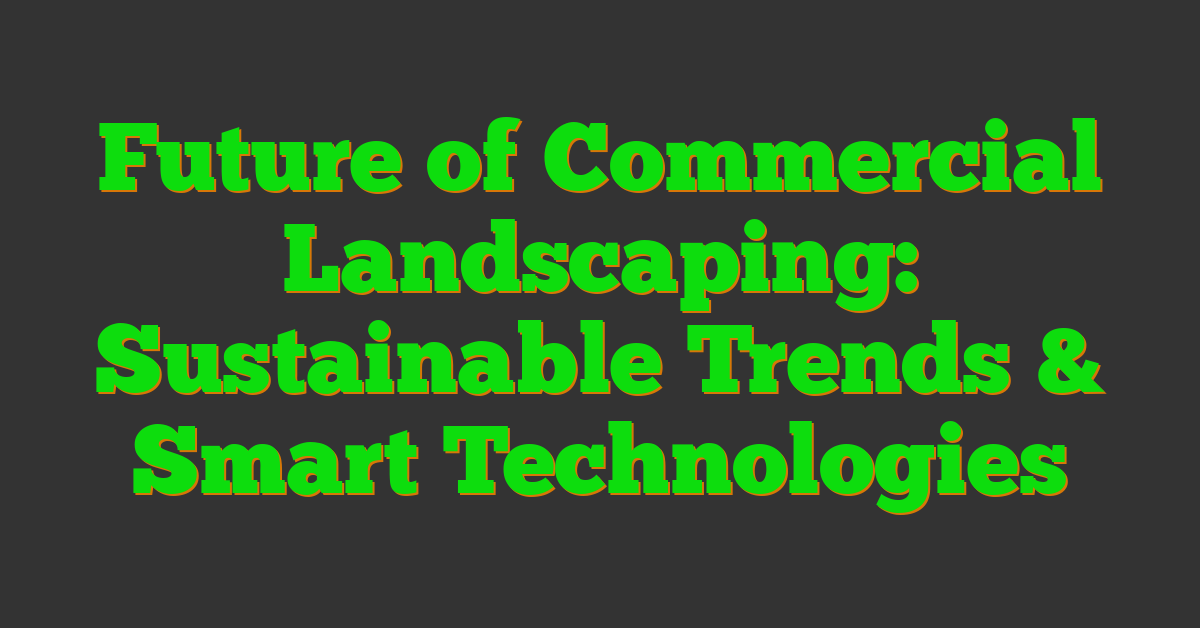Imagine stepping into a commercial space where every green element not only enhances beauty but also promotes sustainability. That’s the exciting future of commercial landscaping I’m eager to explore.

As businesses prioritize eco-friendly practices, landscaping is evolving beyond aesthetics. Smart technologies, innovative plant selections, and sustainable materials are transforming outdoor spaces into vibrant, functional environments. I believe these changes will redefine how we interact with our workplaces and communities.
Join me as we delve into the trends and advancements shaping the future of commercial landscaping, and discover how these innovations can create lasting positive impacts for businesses and our planet.
Emerging Trends in Commercial Landscaping
- Biophilic Design: Incorporating natural elements like plants, water features, and natural light into commercial spaces enhances employee well-being and productivity. It’s an effective way to create inviting and healthy work environments.
- Vertical Gardens: Utilizing vertical spaces for plant installations maximizes greenery without consuming valuable floor space. These living walls improve air quality and add aesthetic value to buildings.
- Smart Irrigation Systems: Deploying AI-driven irrigation technologies optimizes water usage by adjusting watering schedules based on weather data and soil moisture levels. This reduces water waste and lowers maintenance costs.
- Sustainable Materials: Using eco-friendly materials such as recycled plastics, sustainable wood, and permeable pavements minimizes environmental impact. These materials contribute to long-term sustainability and align with green building standards.
- Renewable Energy Integration: Integrating solar panels and wind turbines into landscaping designs provides renewable energy sources for irrigation systems and lighting. This approach reduces energy consumption and operational costs.
- Drought-Resistant Plants: Selecting native and drought-resistant plant species decreases the need for excessive watering. These plants thrive in local climates, ensuring resilience and reducing maintenance efforts.
- Robotic Maintenance Tools: Implementing robotic mowers and automated maintenance equipment enhances efficiency and precision in landscape upkeep. These tools lower labor costs and ensure consistent maintenance standards.
- Outdoor Connectivity: Providing Wi-Fi and power outlets in outdoor landscaped areas supports remote work and enhances the usability of outdoor spaces. This trend caters to the growing demand for flexible and connected work environments.
- Integrated Technology Monitoring: Utilizing sensors and IoT devices to monitor soil health, plant growth, and environmental conditions allows for proactive landscape management. This technology ensures optimal plant health and resource utilization.
| Trend | Benefits |
|---|---|
| Smart Irrigation Systems | Reduces water waste by up to 30%, lowers costs |
| Renewable Energy Integration | Decreases energy consumption by 20%, sustainable |
| Robotic Maintenance Tools | Cuts labor costs by 15%, ensures consistency |
Sustainable Practices
Implementing sustainable practices in commercial landscaping enhances environmental responsibility and operational efficiency. These methods focus on reducing resource consumption and minimizing ecological impact.
Eco-Friendly Materials
Selecting sustainable materials reduces environmental footprint and maintenance costs. I prioritize materials like recycled composites for decking, permeable pavers to enhance water drainage, and native stone that requires minimal processing.
Water Conservation Techniques
Efficient water management decreases consumption and preserves local water sources. I utilize smart irrigation systems that adjust based on weather data, install rainwater harvesting systems to collect and reuse precipitation, and choose drought-resistant plant species that thrive with minimal watering.
Technological Advancements
I’ve seen how technology reshapes commercial landscaping, enhancing efficiency and sustainability.
Smart Landscaping Technologies
Smart technologies integrate sensors and data analytics to optimize landscape management. For example, smart irrigation systems use AI to adjust water usage based on weather patterns.
| Technology | Benefit |
|---|---|
| Smart Irrigation Systems | Reduce water waste by 30% |
| IoT Soil Sensors | Monitor soil moisture |
| Plant Health Monitors | Enhance plant longevity |
Additionally, IoT devices monitor soil conditions and plant health, enabling proactive maintenance and improving overall landscape vitality.
Automation and Robotics
Automation streamlines maintenance tasks, saving time and costs. Robotic lawnmowers handle regular mowing with precision and minimal supervision. Similarly, automated fertilizing and pesticide application systems ensure consistent and accurate distribution, minimizing chemical usage and environmental impact.
Environmental Impact
Commercial landscaping significantly influences environmental sustainability. By implementing eco-friendly practices, I reduce carbon emissions, conserve water, and enhance biodiversity.
Carbon Footprint Reduction
I adopt native plant species to minimize transportation and maintenance needs. Native plants typically require fewer fertilizers and pesticides, decreasing greenhouse gas emissions.
| Practice | Impact |
|---|---|
| Native Plant Usage | Reduces transportation emissions |
| Organic Fertilizers | Lowers greenhouse gas emissions |
| Efficient Lighting | Decreases energy consumption |
Water Conservation
I utilize efficient irrigation systems, such as smart irrigation, to optimize water usage. These systems adjust watering schedules based on real-time weather data, preventing overwatering.
| Technology | Water Savings (Annual) |
|---|---|
| Smart Irrigation | 30% reduction |
| Rainwater Harvesting | 25% increase in usage |
| Drought-Resistant Plants | Lower water demand |
Biodiversity Enhancement
I incorporate diverse plant species to foster a healthy ecosystem. Diverse habitats support various pollinators and wildlife, promoting ecological balance.
- Pollinator Gardens: Attract bees, butterflies, and other pollinators
- Habitat Creation: Provides shelter for birds and beneficial insects
- Organic Practices: Maintains soil health and plant vitality
Pollution Mitigation
I utilize sustainable materials and practices to reduce pollution levels. Permeable pavements allow rainwater infiltration, decreasing runoff and preventing water pollution.
| Practice | Pollution Reduction |
|---|---|
| Permeable Pavers | Lowers surface runoff |
| Recycled Materials | Minimizes waste |
| Organic Pest Control | Reduces chemical pollution |
Economic Considerations
Investing in sustainable commercial landscaping offers significant cost savings over time. Implementing smart irrigation systems can reduce water expenses by up to 30%. Additionally, using native plants minimizes maintenance costs due to their adaptability to local conditions.
| Investment | Initial Cost | Annual Savings |
|---|---|---|
| Smart Irrigation Systems | $10,000 | $3,000 |
| Native Plant Selections | $5,000 | $1,500 |
| Robotic Maintenance Tools | $15,000 | $4,500 |
Adopting eco-friendly materials lowers long-term expenditures. Recycled composites and permeable pavers decrease the need for frequent replacements and reduce waste management fees. Furthermore, energy-efficient lighting systems cut electricity bills by approximately 20%.
Tax incentives support the transition to sustainable landscaping. Federal and state programs offer rebates and credits for businesses that implement green practices. These financial incentives can offset initial setup costs, making eco-friendly investments more accessible.
Market demand for sustainable landscapes is rising, enhancing property values. Businesses with green outdoor spaces attract more clients and tenants, leading to increased revenue. The return on investment for sustainable landscaping projects typically ranges from 5 to 10 years, depending on the scale and specific implementations.
« How to Create a Hardscape Seating Area: Step-by-Step Guide Caring for Evergreen Trees and Shrubs: Essential Tips for a Beautiful Garden »
By prioritizing economic factors, commercial landscaping can achieve both financial and environmental benefits. Sustainable practices not only reduce operational costs but also contribute to a positive bottom line.
Conclusion
Seeing the transformation in commercial landscaping is truly inspiring. Embracing eco-friendly practices not only enhances spaces but also benefits our planet.
Smart technologies bring efficiency and innovation making landscape management easier and more sustainable. Investing in these trends is a win-win for businesses and the environment.
I’m excited about the future where green spaces thrive with minimal impact. Adopting these advancements can lead to healthier environments and flourishing businesses.
Let’s stay ahead by integrating sustainability and technology into our outdoor spaces creating vibrant and resilient landscapes for years to come.















